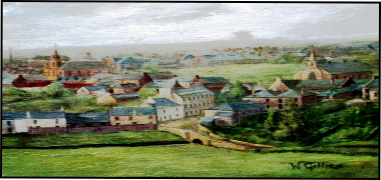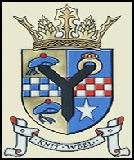Stewarton & District Historical Society Scottish Charitable Incorporated Organisation : SC011194.

Dunlop Street 1970D

Stewarton Viaduct 2008
Coat of Arms reproduced by permission of Stewarton Community Council

Springwell Place 1860

Site produced by
“Davie McKie’s Web Designs.”
Updated
26th January 2024
David Dale
Stewarton's most famous son was probably David Dale, the founder of New Lanark.
It is generally accepted that his family came from Stacklawhill farm outside the town, and his parents, Annie Blackwood and William Dale are buried in St Columba's Kirkyard.
The mystery is -
According to local tales he was born on the site of The Granary in Rigg Street, but the family never owned this property. William did however own a yard between the 'Granary' and the Cross. This yard passed to David, and in turn to his daughters, so it was in the Dale family well into the 19th. century.
According to the Title Deeds of The Granary, a Dispositon of May 30th., 1790, by
John Brownlee to James McGowan states that -
In 1807 another disposition calls it 'the yard now belonging to the heirs of the late David Dale, merchant in Glasgow...(i.e. his daughters).'
Unfortunately we cannot guarantee that he was born there -
He moved to Paisley, to learn to be a weaver, then became an intinerant 'packman' travelling from farm to farm buying yarn or cloth. Later he opened a shop in Glasgow High Street near Glasgow Cross, where he became the first agent of the Royal Bank of Scotland.
As well as having shares in mills in Blantyre, Catrine, and Spinningdale (Sutherland), etc., he also lent thousands of pounds to help build Stanley Mills in Perthshire which have recently been restored by Historic Scotland. He was also a founder member of the Glasgow Chamber of Commerce, as well as being a Baillie in the city, donated money for the building of the Anderson Institute (now Strathclyde University)and built a large house in Charlotte Street.
He was also a deeply religious man, became a lay preacher in the city and sent money to the poor people of Stewarton in times of hardship.
He eventually died in Charlotte Street in 1806 and was buried in the Ramshorn Kirkyard in Ingram Street in the Merchant City, but he had no sons to whom he could leave his fortune, only daughters.



New Lanark Mills.
D -
Ian’s A-
David Dale